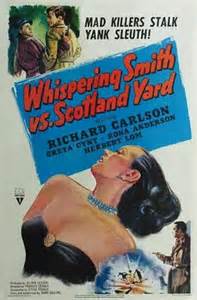| Whispering Smith Hits London | |
|---|---|
 Poster for US theatrical release | |
| Directed by | Francis Searle |
| Written by | Frank H. Spearman (story) |
| Screenplay by | John Gilling Steve Fisher |
| Produced by | Anthony Hinds Julian Lesser |
| Starring | Richard Carlson Greta Gynt Rona Anderson Herbert Lom |
| Cinematography | Walter Harvey |
| Edited by | James Needs |
| Music by | Frank Spencer |
Production company | |
| Distributed by | Exclusive Films RKO Radio Pictures (US) |
Release date |
|
Running time | 82 minutes (UK) 77 minutes (US) [2] |
| Country | United Kingdom |
| Language | English |
Whispering Smith Hits London (U.S. title Whispering Smith vs. Scotland Yard) is a 1952 British second feature ('B') [3] crime drama directed by Francis Searle and starring Richard Carlson, Greta Gynt and Herbert Lom. [4] [5] The screenplay was by John Gilling and Steve Fisher, based on a story by Frank H. Spearman. Gilling said in interviews that he had to sue to get his writer's credit on this film, which infuriated James Carreras who was planning to credit only Spearman. It was made at Bray Studios with some location shooting in London. Production ran from May 14, 1951 through June 21, 1951. The original working title for the film was Whispering Smith Investigates, but it was changed to Whispering Smith Hits London just before it was trade shown on Jan. 17, 1952 at the Rialto, then released on Feb. 3rd. The film was distributed in the US in March 1952 by RKO, in a slightly edited version retitled Whispering Smith vs. Scotland Yard. Michael Carreras was working on the script for a sequel to this film, but plans for a series was dropped. [6]